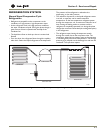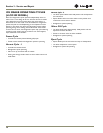
3-1
Section 3 - Service and Repair
REFRIGERATION SYSTEMS
Normal Vapor/Compression Cycle
Refrigeration
• Refrigerant is pumped from the compressor to the
condenser as a high pressure, high temperature vapor.
• As the refrigerant cools in the high pressure condenser,
the vapor condenses to liquid. During this phase change, a
great amount of heat is rejected with the help of the
condenser fan.
• The liquid then flows to the dryer where is strained and
filtered.
• From the dryer, the refrigerant flows through the capillary
tube which meters the liquid refrigerant to the evaporator.
The pressure of the refrigerant is reduced to the
evaporating, or low side, pressure.
• The reduction of pressure on the liquid refrigerant causes
it to boil, or vaporize, until it reaches saturation
temperature. As the low temperature refrigerant passes
through the evaporator coil, it continues to absorb a lot of
heat, causing the boiling action to continue until the
refrigerant is completely vaporized. It is during this phase
change that most heat is absorbed (the cooling takes place)
in the refrigerator.
• The refrigerant vapor leaving the evaporator travels
through the suction line to the compressor inlet. The
compressor takes the low pressure vapor and compresses
it, increasing both pressure and temperature. The hot high
pressure gas is pumped out the discharge line and into the
condenser. The cycle then repeats
.
Figure 1. Normal Vapor/Compression Cycle Refrigeration System
CAPILLARY TUBE
DRYER
CONDENSER
COMPRESSOR
EVAPORATOR
UL183-1


















